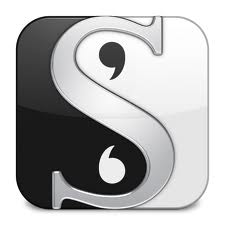 Back in June, I published several posts on my experience with Scrivener (here, here, here, and here). At that time, I was still in my trial period phase with Scrivener and mostly I had imported a small project and done some tinkering.
Back in June, I published several posts on my experience with Scrivener (here, here, here, and here). At that time, I was still in my trial period phase with Scrivener and mostly I had imported a small project and done some tinkering.
Since then, I’ve purchased Scrivener and done several full-length projects, including some novellas, short stories, and novelettes. And I’ve come to a couple of conclusions.
1. Scrivener rocks.
2. How did I get along in Word for so long?
First, a clarification. I said in my Step 2 post that the trial goes by 30 days of actual use. That turned out to be incorrect. It uses actual calendar days. And you can’t cheat it by simply leaving it open. It must check the system clock for the date.
I admit I got a little lazy. I was writing the second story using some of the same characters, and I thought “Oh, I know all about these folks.” But somewhere along the way, I thought “Wait, does she have green eyes or blue?” Yep, I had forgotten the color of my own character’s eyes. I thought I’d have to recreate all my character sheets, but figured I’d check to see if I can drag and drop. Turns out you can. Open both projects and drag from Project A to Project B. Sweet.
For me, the true beauty of Scrivener lies in the fact that it is designed to write scene by scene. In theory, you can do this in Word. But the problem for me in Word was always organization. If I wrote each scene in a separate file, how would I ever paginate and print the whole thing easily? Not to mention I’d end up with literally hundreds of files to store, organize, and name. Jumping between them? Forget it. It was only marginally better if I created a separate file for each chapter.
But writing scene by scene is exactly what Scrivener was designed to do. I create folders for each chapter. Then I can think, “What do I need to accomplish next?” and I write it. Since I recently took a course on scene writing, this is perfect. Instead of getting tempted to think way out in the future, I can concentrate on the scene in front of me. What kind of scene, what is the goal, how does it contribute to the story question?
Writing this way, scene by scene, also makes reorganizing so much easier. I got some edits back on a story that made me realize that not only was I going to have to write new scenes, I had to reorder some of the scenes I already had. In Word, this would have been a complete nightmare. Where did I put that scene? Find it (often by hit or miss method), cut, paste to new document, find the new location, paste.
With Scrivener, this is a snap. The scenes are named and if I’ve been smart (which I haven’t always been), the synopsis tells me that yes, this is in fact the scene I was looking for. Then I just drag and drop it to it’s new location. I don’t have to worry about pagination. Scrivener does that in the compile process.
The first time I did it, I wanted to weep with tears of joy.
Speaking of the compile process, it rocks too. I submitted a manuscript to a magazine for publication. I hit compile and compared the output to the submission guidelines. I only had to make a few tweaks because the margins, font, and paragraph spacing, as well as the address block at the beginning, was already perfect (headers and footers were where I had to make most of my changes, but only on the second submission).
One small nitpick about compile and chapters: If you don’t name your chapters (e.g., Chapter 1, Mary Goes to the Store), you’ll have text you need to delete – either the placeholder text you used for your folders or “unnamed document.” As I don’t name my chapters (hell, I have a hard enough time coming up with a title for the entire story much less for every chapter) this is a little irritating, but minor. I would love it if Scrivener would be smart enough to drop that paragraph if the folder is not named.
Project targets are great if you have a target word count. For example, I recently wrote a short story that had to be 6,000 words or less. By setting the project target word count, I knew that if I’d reached the 5,000 word mark and was only 2/3 of the way through the story I was in trouble. Session targets are great if you are doing things like 1k1hr or have a target count for the day.
Some things I’ve learned:
- Don’t shortcut and skip the character or location sheets. They will really make you think about everything you introduce in the story, including such important things as character conflict. They will also keep you from forgetting that the house is supposed to be white with blue trim, not blue with white trim. Because you will forget. Trust me.
- Don’t import a Word document that is hundreds of pages and thousands of words. I tried. It was messy. Just don’t.
- Scrivenings are your friend. Using those, I can read an entire chapter (or any other selection) end-to-end. And I can make any changes right there, I don’t have to jump back to the individual document.
- Take the time to familiarize yourself with the Preference. Because it turns out yes, you can set the default font and spacing so you don’t have to do it for every project. Every. Single. Document.
Update: For more information on purchasing Scrivener, or downloading a trial version, go to the Literature and Latte web site. Scrivener is also available for purchase through the Mac App Store.

Hi Mary. Thanks for the Scrivener update. I followed your earlier post on it then I got sidetracked and didn’t follow through. Maybe this will be the push I need to give it a try.
I am so sorry for the delay – got a new job and things have been hectic.
Yes, do download the trial. It has completely changed the way I think about and structure my writing – all for the better.
And I keep forgetting to mention a really cool feature. It has a Name Generation engine. Plug in your variables and it will generate tons of names, even ethnic ones. For someone who struggles with names, that’s really cool.
I’ve been using Scrivener for over a year now, and I couldn’t praise it highly enough 🙂
Ellen, sorry for the delay in responding. I was out of town for the Labor Day holiday then started a new job.
I’d been hearing for years from friends about how cool Scrivener was, but I’d just never bothered to try it. Since I was unemployed this summer, I decided to give it a whirl. Now I’m sorry I waited so long.